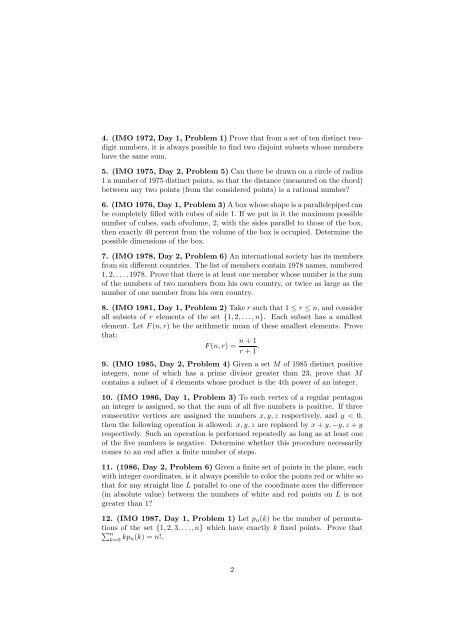Combinatorics Problems
Combinatorics Problems
Combinatorics Problems
You also want an ePaper? Increase the reach of your titles
YUMPU automatically turns print PDFs into web optimized ePapers that Google loves.
4. (IMO 1972, Day 1, Problem 1) Prove that from a set of ten distinct twodigit<br />
numbers, it is always possible to find two disjoint subsets whose members<br />
have the same sum.<br />
5. (IMO 1975, Day 2, Problem 5) Can there be drawn on a circle of radius<br />
1 a number of 1975 distinct points, so that the distance (measured on the chord)<br />
between any two points (from the considered points) is a rational number?<br />
6. (IMO 1976, Day 1, Problem 3) A box whose shape is a parallelepiped can<br />
be completely filled with cubes of side 1. If we put in it the maximum possible<br />
number of cubes, each ofvolume, 2, with the sides parallel to those of the box,<br />
then exactly 40 percent from the volume of the box is occupied. Determine the<br />
possible dimensions of the box.<br />
7. (IMO 1978, Day 2, Problem 6) An international society has its members<br />
from six different countries. The list of members contain 1978 names, numbered<br />
1, 2, . . ., 1978. Prove that there is at least one member whose number is the sum<br />
of the numbers of two members from his own country, or twice as large as the<br />
number of one member from his own country.<br />
8. (IMO 1981, Day 1, Problem 2) Take r such that 1 ≤ r ≤ n, and consider<br />
all subsets of r elements of the set {1, 2, . . ., n}. Each subset has a smallest<br />
element. Let F(n, r) be the arithmetic mean of these smallest elements. Prove<br />
that:<br />
F(n, r) = n + 1<br />
r + 1 .<br />
9. (IMO 1985, Day 2, Problem 4) Given a set M of 1985 distinct positive<br />
integers, none of which has a prime divisor greater than 23, prove that M<br />
contains a subset of 4 elements whose product is the 4th power of an integer.<br />
10. (IMO 1986, Day 1, Problem 3) To each vertex of a regular pentagon<br />
an integer is assigned, so that the sum of all five numbers is positive. If three<br />
consecutive vertices are assigned the numbers x, y, z respectively, and y < 0,<br />
then the following operation is allowed: x, y, z are replaced by x + y, −y, z + y<br />
respectively. Such an operation is performed repeatedly as long as at least one<br />
of the five numbers is negative. Determine whether this procedure necessarily<br />
comes to an end after a finite number of steps.<br />
11. (1986, Day 2, Problem 6) Given a finite set of points in the plane, each<br />
with integer coordinates, is it always possible to color the points red or white so<br />
that for any straight line L parallel to one of the coordinate axes the difference<br />
(in absolute value) between the numbers of white and red points on L is not<br />
greater than 1?<br />
12. (IMO 1987, Day 1, Problem 1) Let p n (k) be the number of permutations<br />
of the set {1, 2, 3, . . ., n} which have exactly k fixed points. Prove that<br />
∑ n<br />
k=0 kp n(k) = n!.<br />
2
















